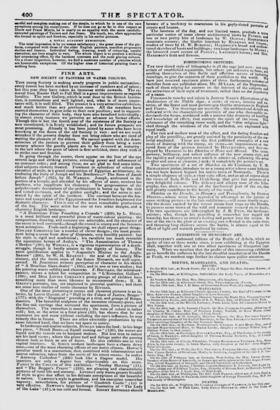FORTHCOMING SKETCHES.
TIIE new tinted style of lithography is all the rage just now : not only artists of established reputation, but others yet unknown to fame, sa availing themselves of this facile rind effective means of imitatinez drawings, to give the contents of their portfolios to the world. avi have just received specimen plates of three forthcoming volumes or sketches from one publisher alone,coMtehel'olt.t.raesart, of thettihlee slolhaiyemetasrkeeetti each of them relying for success
the attraction of their style of treatment, rather than on the popularity of a name.
Foremost in novelty and talent is JOSEPH NASH'S Illustrations ofthe Architecture (f the Middle Ayes; a series of views, interior and ex- terior, of the finest and most picturesque Gothic structures in England and France. Tin.. drawings are masterly : the architectural details are indicated with the characteristic precision of one who thoroughly tin. derstands the fortns, combined with a painter-like dexterity of handling and knowledge of effect, that conveys the spirit of the scene. The substance of the crumbling stone work, and the "dim religious light" shed through the windows of the old cathedral, are expressed with equal truth. The rich and mellow tone of the effect, and the daring freedom and play of the pencilline, are greatly assisted by the peculiarity of the ma, terial employed. These are the first published examples of a new mode of drawing with the stump, on stone—an improvement or ma- tured form of the process invented by HeLLMANDEE, and first em- ployed by HARDING in his Shetches at Home and Abroad. The trans- parency, brilliancy, and velvet softness of the new. stump style, and the rapidity and negligent ease svhich it admits of, (allowing the artist to alter and erase at pleasure,) make it completely the painter's art. Two specimens of a set of' Sketches oil ihe Continent, by T. M. RICHARDSON junior, introduce to us a young artist whose name hitherto has not been known beyond his Dative town of Newcastle. There is a simple elegance of style, a dear calm effect, and an air of repose about the views of Isola 13.11a and I leidelberg, that give fair promise of a very delightful volume. The delieriey rind silvery tune of the litho- graphy, too, show a mastery of the mechanical part of the art, that will greatly contribute to the beauty of the ■voi k. Shetches on the Danube, in Hungary and 7'ransylrania, by GEORGE HERING—whose name has appear( d to atirantagO as the painter of some striking pictures in the late exhibitions—will come timely to gra. tify the desire excited by the recent steam•boat trips up the Danube, to possess some views of the wild and romantic scenery on its banks. The two specimens are lithographed by J. B. PYNE, the landscape- painter ; who, though his pencilling is somewhat too ragged and scratchy, has thrown an artist's feeling and power into the scenes. In one of the views the glow of an evening sun reflected in the calm river, and throwing long shadows across the banks, is almost equal to the effect of light and warmth produced by colour.


























 Previous page
Previous page